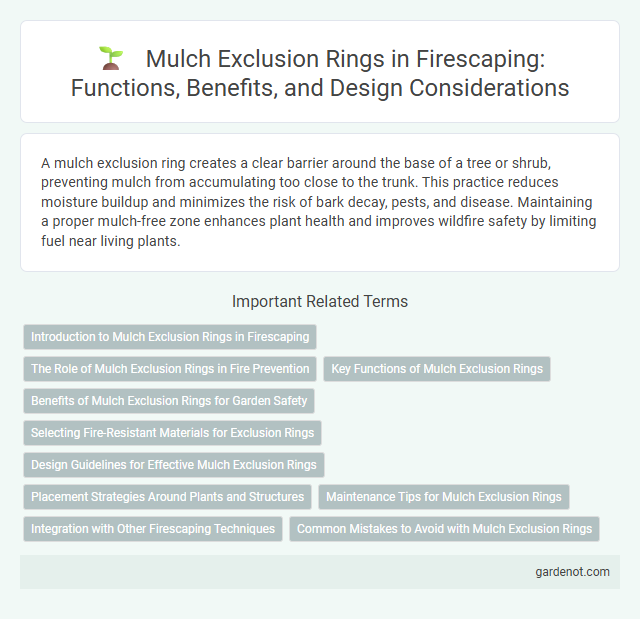A mulch exclusion ring creates a clear barrier around the base of a tree or shrub, preventing mulch from accumulating too close to the trunk. This practice reduces moisture buildup and minimizes the risk of bark decay, pests, and disease. Maintaining a proper mulch-free zone enhances plant health and improves wildfire safety by limiting fuel near living plants.
Introduction to Mulch Exclusion Rings in Firescaping
Mulch exclusion rings create a fire-resistant barrier around trees and shrubs by keeping combustible mulch away from the plant base, reducing ignition risks. These rings are typically made from non-flammable materials such as metal or stone, ensuring long-lasting protection in defensible space landscaping. Proper installation of mulch exclusion rings is crucial in firescaping to prevent fire from reaching vegetation and enhancing overall landscape safety.
The Role of Mulch Exclusion Rings in Fire Prevention
Mulch exclusion rings create a defensible space by maintaining a clear, non-combustible area around the base of plants, significantly reducing fire risk. These rings prevent mulch from accumulating directly against plant stems or tree trunks, which can act as fuel during wildfires. Proper installation of mulch exclusion rings is crucial for fire-resistant landscaping and enhancing the effectiveness of firescaping strategies.
Key Functions of Mulch Exclusion Rings
Mulch exclusion rings serve as a critical fire prevention measure by creating a clear barrier that stops mulch from encroaching on the base of trees and shrubs, reducing fuel continuity in wildfire-prone areas. They improve fire resistance around plants by maintaining a non-combustible zone, limiting fire spread and intensity. These rings also help preserve soil moisture and root health by controlling mulch placement, promoting plant vitality while enhancing landscape safety.
Benefits of Mulch Exclusion Rings for Garden Safety
Mulch exclusion rings protect tree trunks by preventing mulch from accumulating directly against the bark, which reduces the risk of moisture-related diseases and pest infestations. These rings improve root oxygenation by allowing better air circulation, promoting healthier plant growth and reducing root rot chances. By creating a clear boundary, mulch exclusion rings also make garden maintenance easier and help prevent damage caused by lawn equipment.
Selecting Fire-Resistant Materials for Exclusion Rings
Selecting fire-resistant materials for mulch exclusion rings is crucial in firescaping to create effective barriers against wildfire spread. Non-combustible options like gravel, stone, or decorative rock reduce the risk of ignition near structures by eliminating flammable mulch contact. Incorporating these materials enhances defensible space, minimizes ember accumulation, and improves overall landscape fire safety.
Design Guidelines for Effective Mulch Exclusion Rings
Mulch exclusion rings should be designed with a minimum width of 18 to 24 inches around tree trunks to prevent mulch contact and reduce moisture buildup that attracts pests and diseases. The ring must be constructed using non-flammable materials and maintain a moist but well-drained soil environment to enhance root health while minimizing fire risk. Proper installation requires keeping mulch at least 6 inches away from the tree base and ensuring the exclusion ring is regularly maintained to remove debris and maintain fire defensibility.
Placement Strategies Around Plants and Structures
Mulch exclusion rings should be placed at least 6 to 12 inches away from plant stems and trunks to prevent moisture buildup and reduce the risk of rot or pest infestation. Maintaining a clear zone around structures such as foundations and fences helps minimize fire hazards by keeping combustible materials at a safe distance. Strategic placement involves creating a mulch-free perimeter that balances soil moisture retention while enhancing fire-resistant landscaping around critical areas.
Maintenance Tips for Mulch Exclusion Rings
Maintain mulch exclusion rings by regularly clearing debris and leaves to prevent moisture buildup that can lead to bark decay and pest infestation. Inspect the soil around the ring for compaction, ensuring it remains loose to promote healthy root aeration and drainage. Reapply a fresh layer of mulch outside the exclusion zone each season to suppress weeds while protecting tree trunks from excess moisture and fire risk.
Integration with Other Firescaping Techniques
Mulch exclusion rings enhance firescaping by creating a clear, combustible-free barrier around plants, reducing wildfire risk and protecting root zones. Integrating mulch exclusion with hardscape elements like gravel beds and stone pathways further limits fuel continuity, strengthening the overall defensible space. This technique complements strategic plant selection and proper irrigation, creating a layered defense that optimizes fire resistance in landscape design.
Common Mistakes to Avoid with Mulch Exclusion Rings
Common mistakes to avoid with mulch exclusion rings include placing the ring too close to the tree trunk, which can trap moisture and lead to rot or pest infestations. Failing to maintain a proper mulch-free gap around the trunk disrupts airflow and can promote fungal diseases. Using rings that are too small or made of non-breathable materials also diminishes their effectiveness in protecting roots and maintaining soil health.
Mulch exclusion ring Infographic

 gardenot.com
gardenot.com